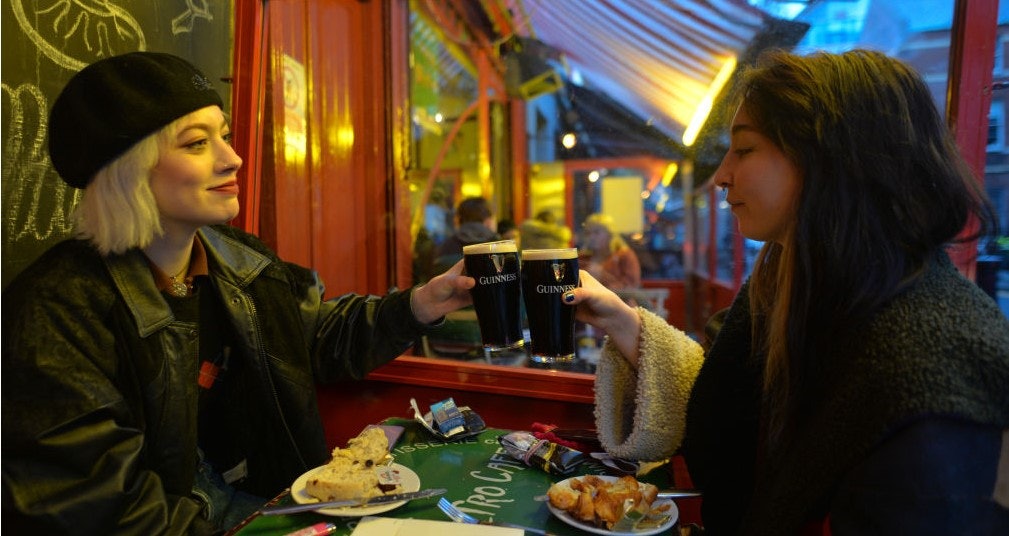Traveling to Dublin this summer? 8 questions to ask yourself before you go

Jun 13, 2022 • 8 min read

No matter the weather, Dublin's outdoor dining scene is taking off since the pandemic © Getty Images
As tourism rebounds, those arriving into Ireland will find that some things have changed, particularly in the capital where accommodation shortages, soaring car rental costs, and airport chaos have all made headlines in recent weeks.
That's not to say the city can't be enjoyed. Dublin is a city that thrives on its reputation for craic (good times) and you shouldn't need help finding any, especially now that COVID-19 restrictions have been lifted. But how has Dublin changed since the pandemic? What can visitors expect?
If you're planning to visit in 2022, here are some questions to consider.
1. Have you booked accommodation in advance?
Soaring hotel costs are wreaking havoc with holidaymakers' budgets, as figures from the Central Statistics Office show price increases of up to 17% for hotel accommodation in Ireland over the last three years.
A report from the Tourism Advisory Group says that tour operators are "scrambling" to find beds in the city and highlights pricing as the main challenge. The problem is compounded by increased demand as travel returns and beds are snapped up, in addition to hotels providing emergency accommodation for refugees fleeing Ukraine, as well as those impacted by the country's worsening housing crisis.
How to have a perfect day in Dublin without spending a euro
It's fair to say finding last-minute accommodation won't be easy. Lonely Planet looked at weekend availability in Dublin city centre in July for two people and average prices ranged between €700 and €900 through Booking.com. In one weekend, the cheapest price was €411 for a private room in purpose-built student accommodation, while the second cheapest was an eye-watering €428 for two beds in a mixed hostel dormitory.
In September, there are slightly more options available but prices are still high, averaging between €500 and €700 for Friday and Saturday nights. Outside of the capital prices are considerably cheaper with prices averaging at about €400 for a two-night weekend stay in Galway in early September and about €300 in Cork for the same period.
If you plan to visit, we recommend you reserve your accommodation as soon as your flight is booked.
2. Have you factored car rental costs into your budget?
Car rental prices in Ireland are high compared to the European average. According to a report from the tourism board, Fáilte Ireland, this is mainly due to supply issues, with stock levels being 50% lower than they were pre-pandemic as rental companies were forced to sell off their cars.
In a case that made headlines in May, one couple was quoted €18,703 to rent a seven-seater car from Dublin Airport for the first week of August. And while that appears to have been an exceptional case, the cost of renting a car will likely make a significant dent in your budget.
For a 10-day hire at the beginning of August, the cheapest option available on Hertz for a Dublin Airport collection is €1,750 for a five-seater, though average prices come in at about €3k for 10 days. With Avis, prices are similar starting at €1748 for a small, four-seater and average prices are about €3k for roomier options.
Speaking to Lonely Planet, Paul Redmond, the chief executive of Car Rental Council of Ireland, said there is no indication yet when supply will increase and the situation will improve.
"Global car production slowed substantially during the pandemic and there is now a huge backlog of orders for new vehicles," he said. "The problem is compounded by component supply issues for the production of new cars. High demand and supply shortages have resulted in more expensive and fewer new cars available to the Irish market. As yet there is no clarity about future supplies."

3. Do you know how to save money on public transport?
Dublin is a notoriously expensive city and the cost of living crisis is continuing to fuel price hikes across everyday goods and services. While car rental costs are soaring, one way you could save money when visiting Dublin this year is through the new 90-minute fare initiative on public transport. It allows passengers to transfer between the city's buses, trams and train services, including Dublin Bus, Luas and most DART and Go-Ahead Ireland, for a flat fare €2 per adult.
The initiative, which can be accessed through the contactless Leap Card, makes it easier and cheaper to navigate Dublin's slightly disjointed public transport network. Transfers must be taken within 90 minutes of the initial departure to avoid incurring any extra charges. Additionaly, tourists can purchase a Leap Visitor Card for unlimited journeys on Dublin's public transport over a select time period.

4. Have you added new attractions to your to-do list?
Creativity is a key part of Dublin's identity and you'll find it represented in the city's world-class museums, galleries and literature hotspots. If you've ticked the classic museums off your list from the National Gallery of Ireland to the Chester Beatty Library, Kilmainham Gaol, and the Irish Museum of Modern Art, you might want to try something new. Just before the pandemic hit, Dublin's newest museum, the Museum of Literature Ireland, opened at the end of 2019 on St Stephen's Green, to showcase why Ireland is the land of storytellers.
These lesser-known Dublin museums might be the city’s best
There's also a new visitor center at the 18th-century Custom House and a new exhibition space that tells the story of Ireland's sporting history at the revamped GAA Museum at Croke Park. If you're looking to further explore Ireland's culture, history and folklore in a more unusual setting, a new indoor exhibition has opened up in Glasnevin Cemetary Museum to complement the popular attraction's outdoor tours.

5. Have you booked your favorite restaurant in advance?
On weekends it's likely you'll have as much chance scoring the winning Lotto ticket as bagging a walk-in in a city centre restaurant. This is despite the fact that Dublin has so many great restaurants to choose from. It may be even because of it, with people wanting to try the latest buzziest place from Michelin-starred fine dining to experimental small-plates wine bars.
Best places to eat in Dublin in 2022
When the pandemic forced almost everything to close, 73% of Dubliners said dining out was the social activity they missed the most and they're seemingly making up for lost time now. If you don't want to miss out, be sure to book at least two weeks in advance for a weekend table and at week in advance for a weekday booking. You might get lucky in the meantime but best to play it safe if you have a special place in mind.
In Dublin, nightlife shines even as historic music venues fall silent

6. What about your favorite pub and bar?
Dublin is a city famously fueled by spontaneity — but as it comes out of pandemic regulations, the city increasingly favors the prepared. During the pandemic, bars and pubs required people to reserve and sit at tables in order to maintain social distancing. The government has scrapped that rule but you'll find that some businesses still enforce it on Friday and Saturday nights when demand is high in the city center. It isn't a hard and fast rule and most places will let you in without a booking regardless. But expect to be standing for much of the night. Again, if there's a special pub on your wishlist it might be a good idea to call ahead and let them know you're coming.
How to find ‘real’ traditional Irish music in Dublin

7. Have you packed your outdoor gear?
Even though you're on a city break, you'll find plenty of great hiking, biking and swimming options in Dublin. The city is cradled by the Wickow Mountains to the southeast and the Irish Sea to the east. It's also home to the largest enclosed public park in any European capital city: the Phoenix Park.
Open-water swimming was popular long before the pandemic, lockdowns seems to have enticed more people into the water. If you're visiting Dublin without a car, you'll find some of the best swimming spots are easily accessible on the DART line from the city center including Sandycove, Vico Baths in Killiney, Howth Cliffs, Bull Island, The Forty Foot and Seapoint.
The same goes for hiking, you can access the scenic Glendalough walking trails by bus from the city center, while the much-loved Bray to Glendalough hiking trail can be reached by DART from the center too.
8. Have you given yourself enough time to catch your flight?
https://twitter.com/DublinAirport?ref_src=twsrc%5Etfw
Finally, make sure you give yourself plenty of time in the airport to catch your flight home — but not too much. Passengers who arrive too early for their flights will be directed to a dedicated passenger holding area outside the terminal buidlings with cover, seating and toilets available. Though it's probably not where you want to spend the last hours of your vacation.
Those taking short-haul flights are advised to arrive two-and-a-half hours before departure times, while those on long-haul flights should arrive three-and-a-half-hours ahead of their flights. If you have to check a bag in, add another hour into that schedule.
The airport has been plagued by long lines at security in recent weeks but a spokesperson for Dublin Airport said they are working to improve the situation by "deploying more staff, opening more security lanes at peak times and implementing a better queue management system inside and outside the terminals."






